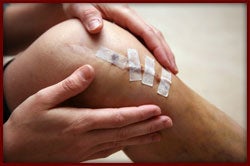Scar Massage—How to Promote Healing
By Martha Walker, Physical Therapist, DPT
 After your transplant surgery, whether you are the recipient or the living donor, everyone from your doctors to your family to your therapists have been telling you it's important to move, to walk, and to work on getting stronger. While this is of utmost importance in order to regain your strength and get back to your life, one thing that may have gotten overlooked is the benefit of scar massage.
After your transplant surgery, whether you are the recipient or the living donor, everyone from your doctors to your family to your therapists have been telling you it's important to move, to walk, and to work on getting stronger. While this is of utmost importance in order to regain your strength and get back to your life, one thing that may have gotten overlooked is the benefit of scar massage.
Your body begins its healing process to the surgical incision as soon as the incision is surgically closed. As the incision begins to heal, scar tissue can build up and limit the range of motion in your chest or abdomen, which can ultimately lead to shortness of breath, difficulty moving your body and arms, and pain with movement. In order to ensure proper healing, which includes a scar that is flexible and mobile, there are some simple techniques you can perform during the healing process.
What is a scar?
A scar is the tissue that is formed from the body's natural healing process in response to an injury, including surgical incisions. Your body begins the process to heal your skin almost immediately, but this process can take up to 1-2 years to fully complete. There are 3 stages in wound healing: the inflammatory, proliferative, and maturation phases. The first stage, the inflammatory phase, is characterized by swelling, redness, and pain and only lasts a few days. The second stage can also be called the regeneration stage as the body works on closing the gap between the edges of your incision. This stage is complete when the wound is fully closed and takes to 2-3 weeks. The final stage, also known as the remodeling phase, starts when there are no open areas in the incision. This final stage can take from 6 months up to 2 years to fully mature. It is in this stage where you may experience restriction and pain with movements, especially if you do nothing to control the scar development.
What is scar massage?
Scar massage is a technique that includes rubbing and deep pressure and is used to prevent the scar from becoming hard and raised, and to prevent it from sticking to the underlying tissues including muscles and bones, which can limit movement. Scar massage is also a way to desensitize the area if you notice your scar is tender or painful when touched. This can be started when the wound is fully healed, when there are no surgical staples, steri-strips, or scabs.
How do I massage my scar?
To perform scar massage, you want to use the pad of your thumb or fingers directly on the scar and begin by rubbing in a circular matter. You want to be sure to give enough pressure to move the scar and skin, not just rub your fingers on top of the scar. You will know you are applying the correct pressure when the skin blanches, becomes white, under your finger and your fingers are not sliding over the scar but the scar is actually moving with the motion of your fingers. Continue in this matter up and down the scar. You then want to move adjacent to the scar and move the skin in all directions, up and down and left and right. It is recommended to perform scar massage on a daily basis to have the greatest affect on scar development, pain reduction, and scar mobility. You should continue daily scar massage for at least the first 6 months and then if the scar is no longer painful and is mobile, you can reduce to 3-4 days a week until the scar is fully mature. This is when the color becomes pale pink and the skin is flat.
Things to remember:
It is important to not let your scar become dry. During massage and throughout the day, you can apply lotion or vitamin E. If you decide to use lotion, be sure to use something that is gentle and without perfume, such as Eucerin or Cocoa Butter. It is best to apply the lotion after the massage to prevent your fingers slipping off the scar resulting in a decreased ability to actually move the scar over the underlying bone and tissue.
Your scar is not as thick as normal skin. Scars generally only reach about 70 to 80% of skins normal strength and therefore can easily be injured. During your scar massage, keep an eye out for blistering, open areas, or a rash. You may be applying too much pressure or being too rough. If this happens, stop massaging in this area and allow it to heal.
Scars are more susceptible to sunburn than regular skin. It is important to keep your scars covered at least for the first year. Also, after that, be sure to apply sunscreen to your scars to prevent burns.
As always, if you have any questions about scar massage or if you want to know if you are doing it correctly, you can contact your physical or occupational therapist.